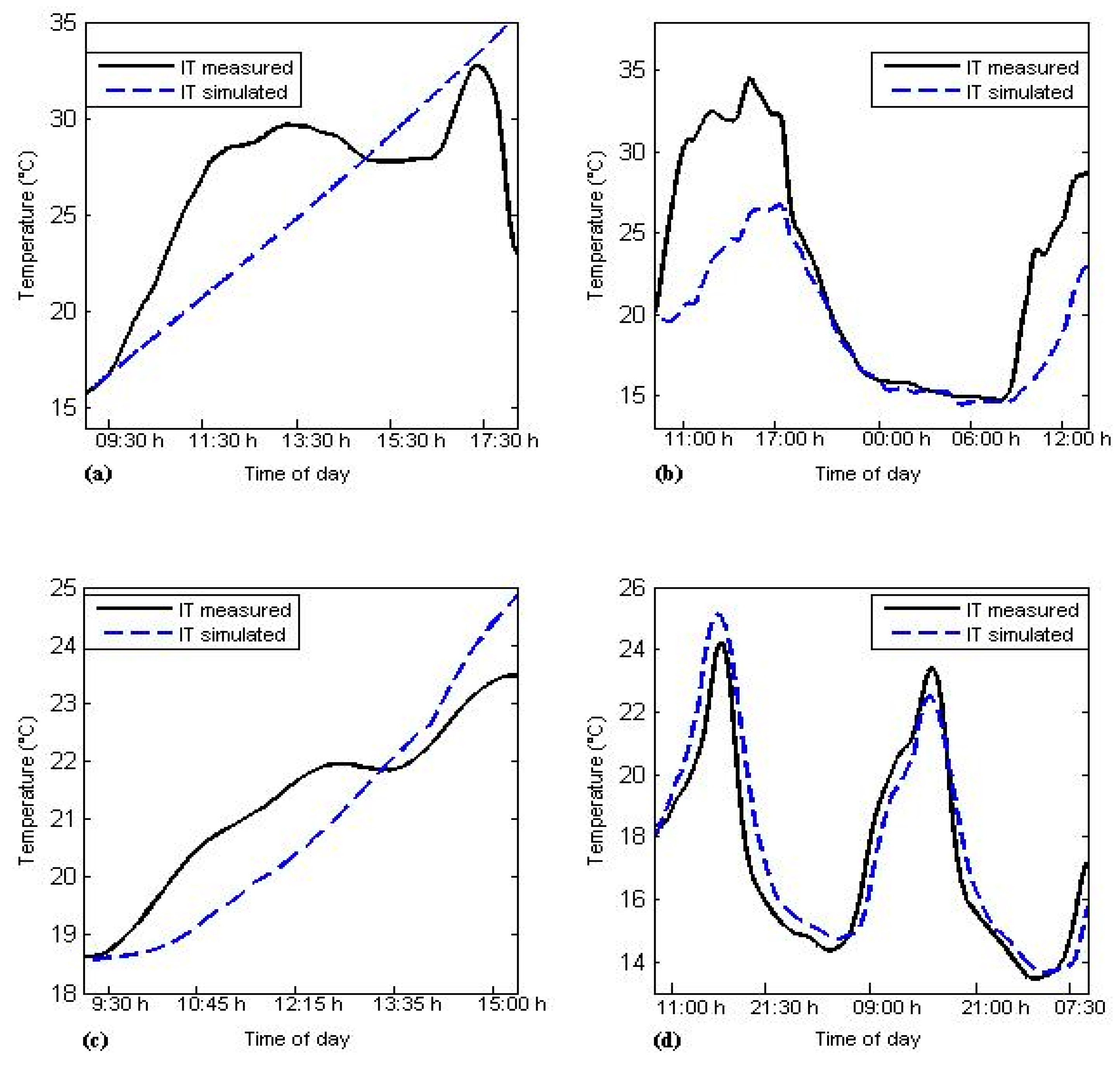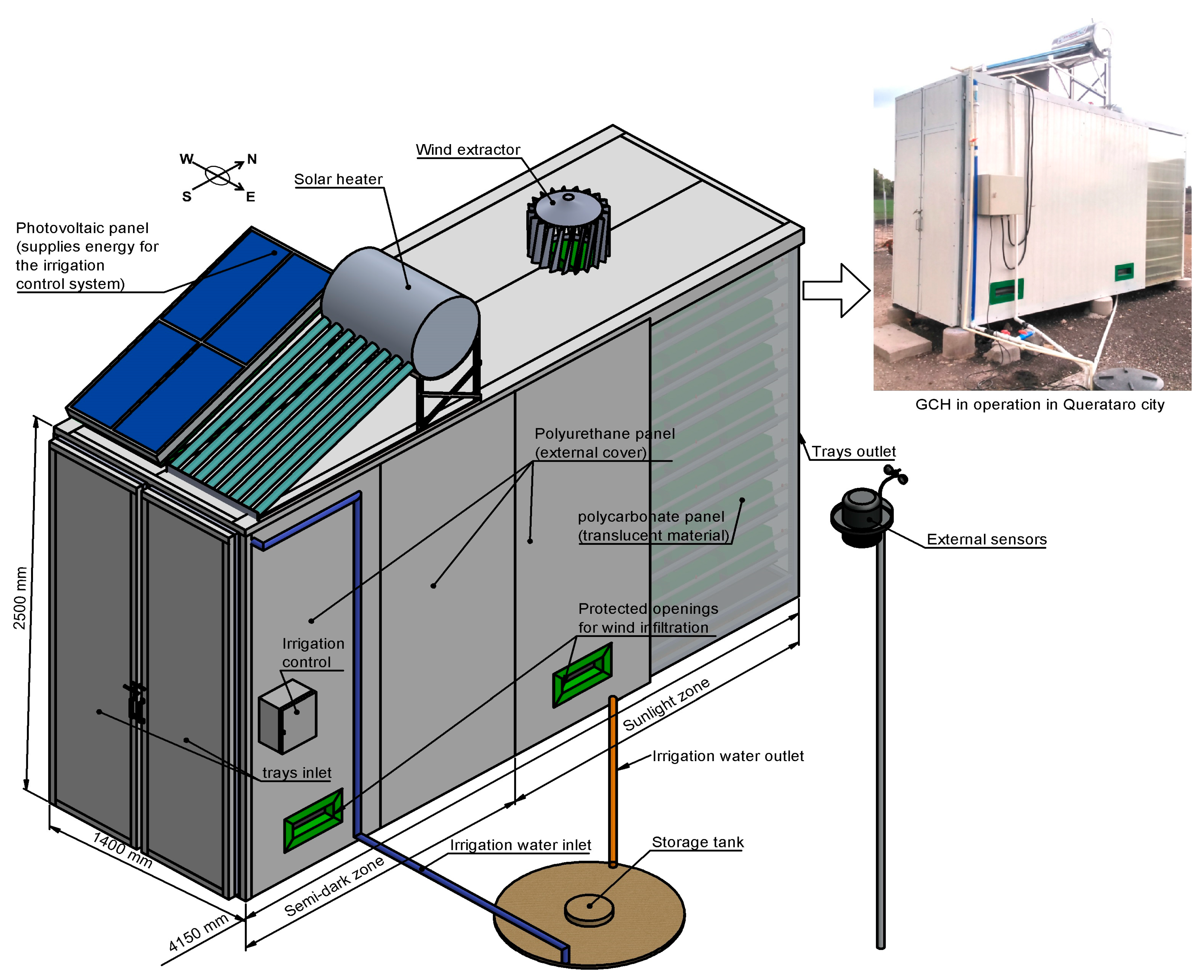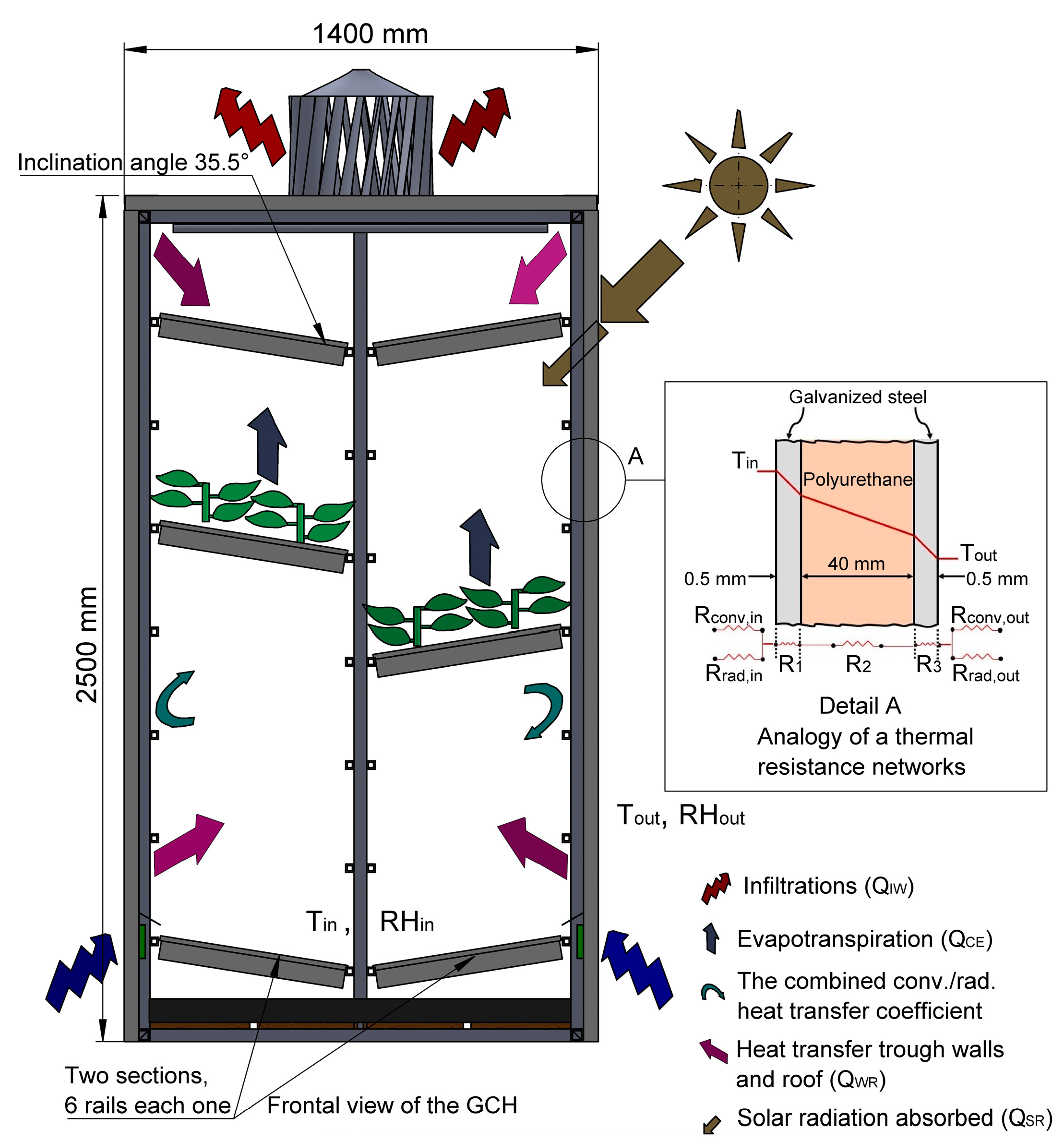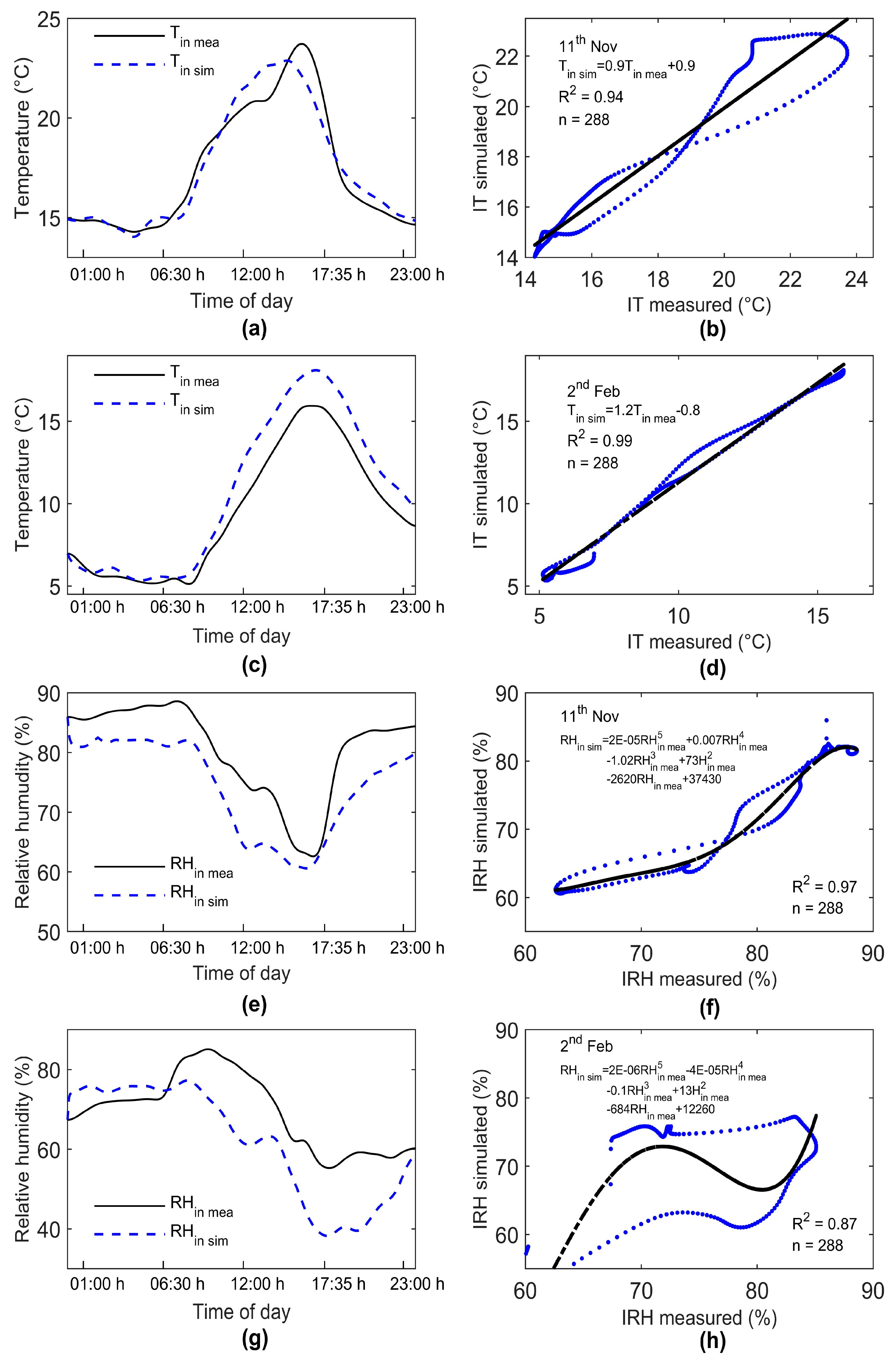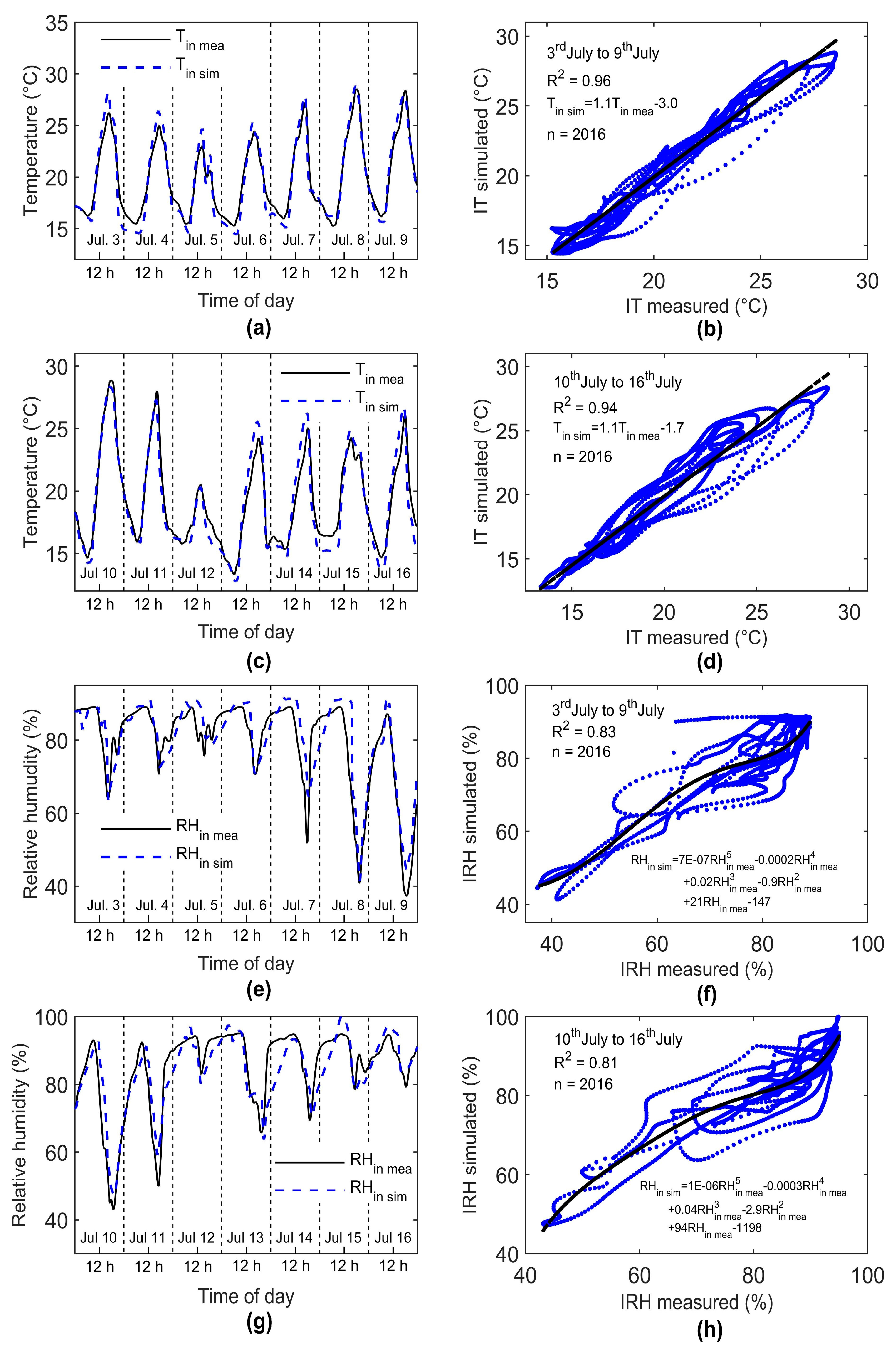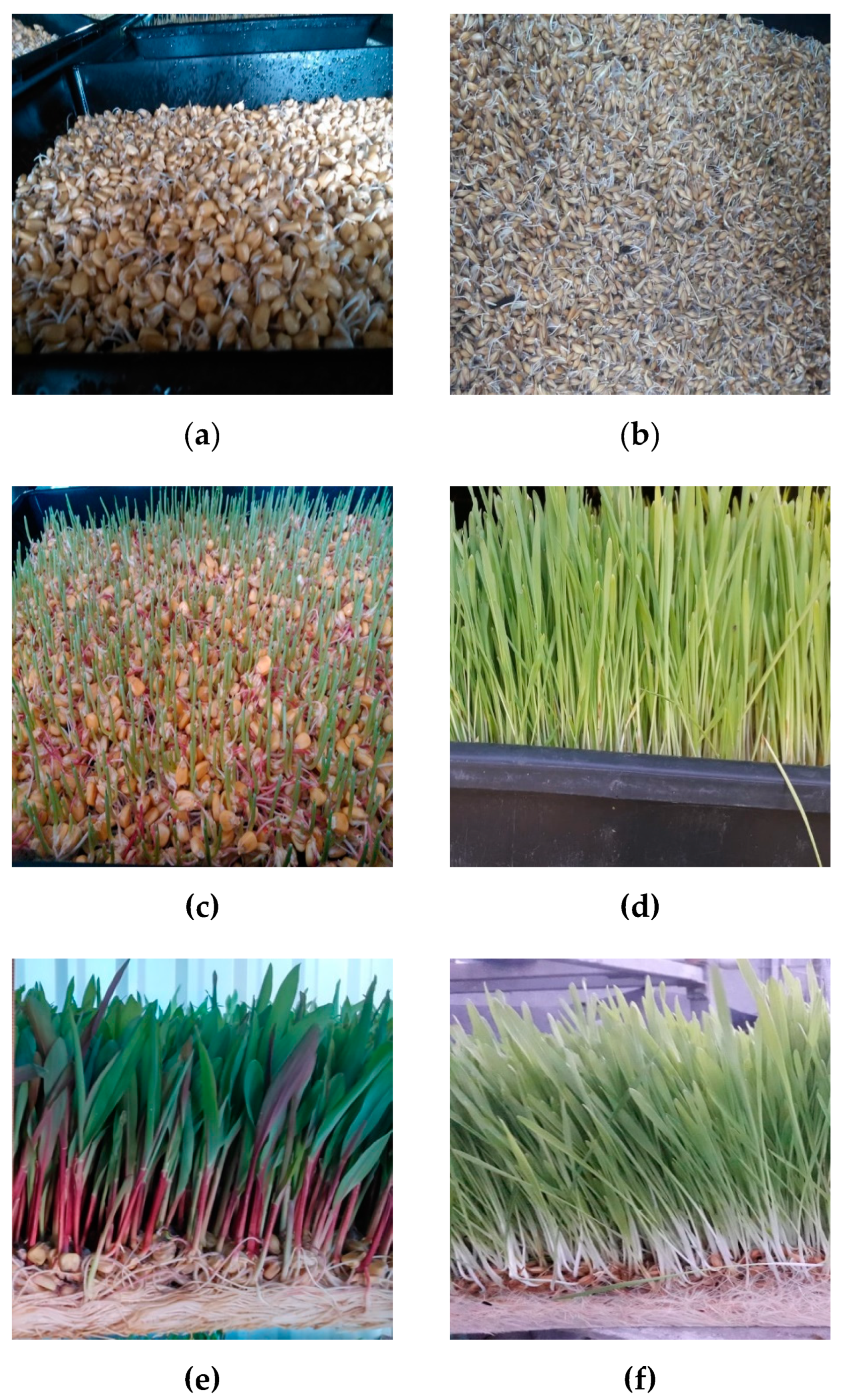This research was carried out on a farm in Querétaro, México (20°32’57.4"N, 100°30’11.7"W), where the GCH is in the open air. To clarify the explanation, this section consists of the following four parts: (1) Growth chamber, in this part describes the camera and all its components; (2) Instrumentation and environmental data, which deals with the sensors used in the study, along with the equation to filter the information; (3) Environmental model, here the mathematical expressions corresponding to the equations of temperature and relative humidity are introduced to analyze the interior of the GCH; and (4) Initial conditions, in which the initial conditions are established to solve the differential equations.
2.1. Growth Chamber
This study centers on the prediction and measurement of the internal air temperature and relative humidity in a GCH built on a farm in the open air, in Querétaro, México.
Its purpose is the growth and development of temporary crops (TCs) of hydroponic green forage (HGF). It is worth mentioning that the crop term used in our work is employed according to the FAO definition (available from
http://www.fao.org/es/faodef/fdef11e.htm), i.e., forage used mainly as part of the animal diet, and that can become temporary.
Figure 1 presents the scheme of the proposed chamber, and a description is given as follows: Due to its design, the GCH uses passive systems to control the temperature, humidity, and wind speed based on filtering outside conditions without operating any climate control system (heating, cooling, or evaporative).
The GCH integrates the concept of renewable energy because it counts with technology that takes advantage of the natural resources for its operation. Furthermore, it is built with an anticorrosive metallic structure with a tubular rectangular profile in stainless steel of 40 × 40 mm, caliber 12, resulting in rigidity. Additionally, covered with a sandwich-type panel of galvanized steel metal faces and a rigid insulating core of high-density polyurethane PUR (40 kg·m−3) with a thickness of 40 mm, model PF600-40L of the company PAINEL2000, which is useful for isolating the interior from the extreme conditions of the elements. On the roof are placed a solar collector, a polycrystalline solar panel of the 125 W brand EPCOM model EPL12512, and a wind extractor brand ATCFANS model BK2000-14 of anodized aluminum. The photovoltaic system ensures the implementation and operation of the GCH anywhere, without relying on conventional electricity, complemented by the following three elements: (1) A solar charge controller with pulse width modulation (PMW), manufactured by PHOCOS model CX40; (2) a RALLY 1200 W inverter model 7466 to convert 12 V DC to 120 V AC; and (3) two solar batteries of a deep cycle of absorbent glass mat (AGM), brand CONER model 31H, 12 V, and 115 Ah. The extractor only rotates because of the external wind present in the GCH installation site (the movement of the wind extractor is ignored, due to the temperature differential). Therefore, ventilation is said to be natural. The lower part of each wall of the chamber (right and left) has two openings, with a stainless-steel mesh 40, SORFORD brand, that prevents the pests or objects entry since the GCH is outdoors. Due to the wind extractor, air enters through these openings and flows upwards. A high-density geomembrane (HDPE) of 1 mm thickness manufactured by GSE covers the wood floor.
The interior of the GCH is divided into two zones: The first part offers semi-dark conditions and must be kept like this during the first eight days, when the seed begins to germinate, and a second part, where the forage shoots are exposed to sunlight to complete their development from the ninth day to the fifteenth day. The lighting is natural thanks to the sun rays that cross the cellular polycarbonate panel (SKYFLEX U-profile 6 mm). In the interior of the GCH, there are 12 rails used to displace the trays horizontally, distributed in two sections, with six rails per section, and rails are separated vertically by 31 cm.
The growth of the HGF takes place in trays of 60 × 40 cm and 7.5 cm high, manufactured by HYDROCULTURA. Each tray has a 35.5° tilt angle with holes in the bottom, allowing water to flow and drain; unlike conventional production systems that use the practice of run and waste irrigation, i.e., the water on the floor is not reused and wasted. Besides, there is a system for the recirculation of water, which lets considerable water savings. This is one of the advantages of the proposed production system.
Additionally, the GCH has a system of irrigation with the following two components: (1) A storage tank of 1000 L, and (2) a submersible water pump of the 250 W brand ORANGEPUMPS model CSP250C-4. The distribution of the water is carried out with PVC tubes that are 13 mm in diameter, with perforations every 64 cm, where there are installed sprinklers manufactured by the EVERGREEN model MS 8009. The irrigation is conducted using pure water, without nutrients and fertilizers.
The GCH is defined as follows: The GCH is a prototype aimed at mitigating or preventing production losses for small and medium livestock producers, or producers of small animals. It has the following characteristics: It is a small chamber, people cannot walk inside it, and only a part of it contains translucent material. Thanks to its shape and size, the chamber can be relocated without disarming it in its entirety, and for its installation and startup, little time is required. The GCH makes efficient use of space due to the structure composed of several layers in a vertical direction. Due to the optimal isolation of the camera, it exhibits an efficient energy consumption.
On the other hand, one would think that a GCH is like a greenhouse; however, there are several differences. For example, a greenhouse is a closed, static, and accessible on foot, and the light crosses the translucent glass or the plastic, letting use of the effect of solar radiation. This structure covers the crop and has at least one device that can be manipulated to control the variables of the environment, nutritional or biotic or both, that influence the growth and development of the crop. Another marked difference between a greenhouse and the GCH is in the commercial aspect because a greenhouse seeks large-scale production that generates economic value, whereas a GCH is used to ensure the production of animal food.
2.2. Instrumentation and Environmental Data
The GCH counts with a temperature sensor and a data logger factory certified and calibrated brand EXTECH model RHT10.The sensor location is 2.08 m behind from the doors, 1.25 m above the floor, and 0.7 m in front of the walls. This device is useful to register and store temperature and relative humidity each day. The resolution and accuracy of the temperature sensor are 0.1 °C and ±1.0 °C, respectively. The resolution of the relative humidity sensor is 0.1%RH. The accuracy changes according to the range of measurement; for the range of 60 to 80%RH, it is of ±3.5%RH, and for 80 to 10%RH, it is of ±5.0%RH. The external weather conditions are obtained from a station Davis Vantage Pro weather, model 6162. This is located outside of the GCH, 4 m to the left from the wall and 3 m from the ground, and permits to capture the following data: Temperature, relative humidity, solar radiation, and wind speed.
In this study, data collected on 11 November 2015 and 2 February 2016 were used to carry out the characterization of the model for simulation purposes. These data were selected because when compared with the information obtained on the other days, they presented major disturbances. The temperature and humidity were acquired every 5 min (measurement interval), obtaining a total of 288 measurements per variable in a day. Other data collected during two consecutive weeks, from 3 July 2016 to 16 July 2016 (15 days were selected because this period corresponds to a cycle of production of HGF), were used to validate the model, i.e., 4320 measurements in 15 days per variable. This measurement interval for data collection was established based on the work reported in [
2,
8].
It is also worth mentioning that the recorded data were filtered to avoid unwanted peaks during the simulation process. The filter used is called median–mean, and it is useful in statistical analysis. This filter computes the mean filter first, followed by the median operator. Formally, this is expressed by:
where,
represents the median–mean filter size
µ;
is the median filter size
µ;
denotes the mean filter size
µ;
represents the input vector;
is the evaluation point;
symbolizes the elemental structuring element; and µ is a size criterion, e.g., if
µ = 1, the number of elements is 2
µ + 1 = 3, and if
µ = 2, then the number of elements is 2
µ + 1 = 5, etc. The filter expressed in Equation (1) was implemented in Matlab® R2010A.
2.3. Environmental Model
The internal environment of the GCH can be described using a system of two differential equations of the first order, which characterize the behavior of the air temperature and relative humidity [
21,
27,
28] following the mass and energy balances considering the interactions illustrated in
Figure 2. External climatic conditions influence this model, as well as the location, orientation, and size of the GCH. The simplified environmental model described in this section takes into consideration next assumptions:
(1) In the temperature model of the air, the heat sources are the heat absorbed through the translucent surfaces, the evapotranspiration of the TC, and the heat transfer through walls and ceiling, while the main source of heat loss is the ventilation. The condensation of the walls (as a result of latent heat) is considered as a parameter neither the water nebulization nor evaporation on the surface of the soil.
(2) The model of humidity in the air considers the evapotranspiration of the crop and ventilation as the main cause of humidity gain and loss, respectively.
(3) The crop evapotranspiration variable utilized in the environmental model comes from some relationships proposed by other authors. Such variables satisfy to be a linear function of the global radiation.
(4) The mathematical relationships of physical processes such as ventilation are simplified. The wind speed within the GCH is considered homogeneous, without considering the multiple crop layers in the GCH. Natural ventilation temperature is despised, due to the small effect of it, with respect to that produced for the wind. Empirical relationships are used to model this physical phenomenon.
(5) The internal temperature and humidity models consider a uniform homogeneous distribution of variables inside the GCH.
2.3.1. The Internal Air Temperature Model
Figure 2 illustrates that the GCH gains heat due to solar radiation absorbed through the translucent surfaces (
QSR), the heat provided by crop evapotranspiration (
QCE), and the heat transfer through walls and roof (
QWR), while the heat losses are due to infiltrations and the effect of wind (
QIW). The equation proposed for modeling the behavior of the internal temperature is the following:
where
is the specific heat at constant pressure (
),
is the air density (
), H represents the average height of the GCH (m).
The heat absorbed by the translucent surface of the GCH due to solar radiation is estimated using the next equation [
29,
30]:
where
is the external global radiation (W∙m
−2), and
is a dimensionless coefficient that relates to the energy transmittance through the translucent material and it is a property of the materials used during its construction.
According to the literature, there are several mathematical models of evapotranspiration for crops [
31,
32,
33], some of which are more complex than others. However, the factor that has demonstrated the highest correlation with evapotranspiration is radiation. Based on the work carried out by Jolliet [
34], we assume that crop evapotranspiration is a linear function of solar radiation. For this reason, Equation (4) expresses the term that associates the heat contributed by evapotranspiration (
) [
29]:
The heat gain through the walls and the ceiling to the interior of the GCH (
QWR) consider (1) the conduction through the wall and roof, and (2) the convection and radiation associated with its surfaces. Equation (5) is defined as [
35]:
, defines the temperature difference between inside and outside of the GCH,
is the total thermal resistance in
.
can be handled using the thermal resistance concept.
Figure 2 (Detail A) illustrates the analogy of the thermal resistance networks.
The Equations (6)–(11) represent the concept of the thermal resistance parameter. This concept is employed, e.g., by Sarafraz et al. [
36], for estimating the overall heat transfer coefficient (
). The equations defined in [
35] are presented as follows:
and
are the convection and radiation heat transfer coefficients at the surfaces;
is the emissivity coefficient;
corresponds to the Stefan–Boltzmann constant;
are the temperatures in the interior and the outside surfaces, respectively;
represents the thermal resistance for the inner and outer sheets of the galvanized steel metal faces with a thickness of 0.5 mm, respectively;
is the thickness of the insulating core;
is the declared thermal conductivity with a value of
. The values are in the technical data sheet of the materials.
Since the convection and radiation resistances are parallel to each other, this may cause some complications in the thermal resistance network. By replacing
in Equations (6) and (10) by
and
, which include the effects of radiation on the inner and outer sheets of the galvanized steel metal surfaces of walls and roofs (called surface conductance, which represents the combined convection and radiation heat transfer coefficients), avoids all the complications associated with radiation effect. The common values for
and
, considering a maximum load, are computed as follows [
37]:
According to the consideration made for the radiation effect, the resistance configuration is in series, hence the total thermal resistance is obtained below:
The energy flow caused by infiltrations and the effect of ventilation is computed below [
30]:
where
represents the airflow through the apertures of the GCH (m
3∙s
−1), and
is the longitudinal area of the camera (
), which is the result of multiplying the width by the height of the GCH.
Subsequently, when replacing Equations (3)–(5) and (15) in Equation (2), the mathematical model to predict the internal air temperature of the GCH is:
2.3.2. The Internal Air Relative Humidity Model
For the relative humidity, the source of water vapor was evapotranspiration from TC (E), and the only water loss from the system was due to ventilation. Then, Equation (17) represents the changes in water vapor produced inside the GCH, i.e.,
Equation (4) establishes the crop evapotranspiration
E (
∙m
−2∙s
−1),
represents the difference between the inside and outside absolute humidity of the GCH, and it is calculated utilizing the next equations [
38]:
where
is the internal relative humidity of the chamber, and
is the value simulated by the temperature obtained through Equation (16).
